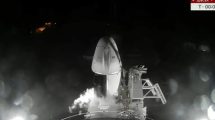
Credits: NASA
NASA and SpaceX have signed an unfunded Space Act Agreement to study the feasibility of a SpaceX and Polaris Programme idea to boost the agency’s Hubble Space Telescope into a higher orbit with the Dragon spacecraft, at no cost to the government.
There are no plans for NASA to conduct or fund a servicing mission or compete for this opportunity; the study is designed to help the agency understand the commercial possibilities.
SpaceX – in partnership with the Polaris Programme – proposed this study to better understand the technical challenges associated with servicing missions. This study is non-exclusive, and other companies may propose similar studies with different rockets or spacecraft as their model.
Teams expect the study to take up to six months, collecting technical data from both Hubble and the SpaceX Dragon spacecraft. This data will help determine whether it would be possible to safely rendezvous, dock, and move the telescope into a more stable orbit.
Thomas Zurbuchen, associate administrator for the Science Mission Directorate at NASA Headquarters in Washington, said: “This study is an exciting example of the innovative approaches NASA is exploring through private-public partnerships. As our fleet grows, we want to explore a wide range of opportunities to support the most robust, superlative science missions possible.”
While Hubble and Dragon will serve as test models for this study, portions of the mission concept may be applicable to other spacecraft, particularly those in near-Earth orbit like Hubble.
Hubble has been operating since 1990, about 335 miles above Earth in an orbit that is slowly decaying over time. Reboosting Hubble into a higher, more stable orbit could add multiple years of operations to its life.
At the end of its lifetime, NASA plans to safely de-orbit or dispose of Hubble.
Jessica Jensen, Vice President of Customer Operations & Integration at SpaceX, added: “SpaceX and the Polaris Programme want to expand the boundaries of current technology and explore how commercial partnerships can creatively solve challenging, complex problems. Missions such as servicing Hubble would help us expand space capabilities to ultimately help all of us achieve our goals of becoming a space-faring, multi-planetary civilization.”












Add Comment